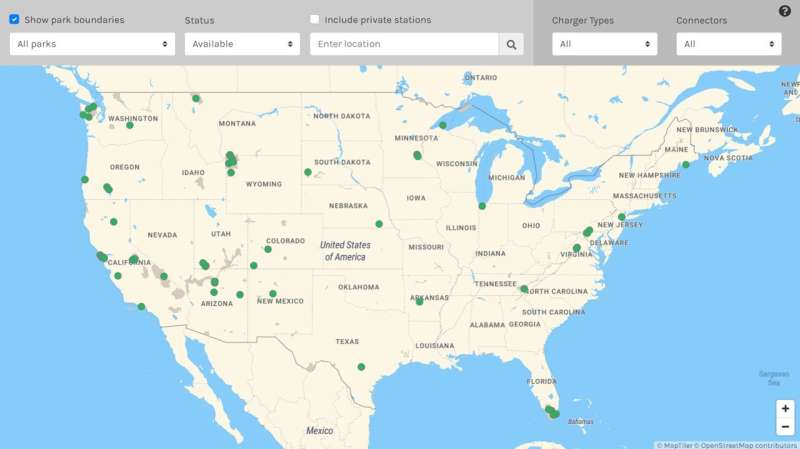
Snacks: Check. Road trip tunes: Check. An interactive map showing electric vehicle charging stations at the national park you are visiting: Check, check, and check.
As electric vehicle (EV) adoption grows—and tourism to U.S. national parks skyrockets—many visitors to the nation's wild spaces have the same question: Can I charge my car there? Now, those visitors can use a new interactive tool built by the National Renewable Energy Laboratory (NREL) to check if an EV charging site can be found at any of the United States' more than 400 national parks, monuments, and historic sites.
Developed in collaboration with the National Park Service (NPS), the tool is now live on the NPS.org website—inviting visitors to help keep the nation's most beautiful heritage sites pristine and emissions-free.
NREL researchers built the NPS Station Locator Tool from the bones of the Alternative Fueling Station Locator, an interactive map that shows nearly every nonresidential alternative fuel station in the United States and Canada, from EV chargers to hydrogen, biodiesel, ethanol, natural gas, propane, and renewable diesel fuel locations. The research team, led by Matt Rahill, an NREL software developer, used the Station Locator's vast data repositories to create a more curated experience for national park visitors.
"Developing an EV charging map for the National Park Service was a way to harness work that we already do at NREL to track charging infrastructure nationwide," Rahill said. "If we were starting from scratch, this project would have taken much longer. Instead, we were able to leverage the existing data from the Station Locator tool and tailor it for national park visitors."
Decades of data power daily EV charging station updates
The data powering both the Station Locator tool and the NPS EV charging map stretches back decades.
Abby Brown, an NREL transportation project manager who serves as the Station Locator's data collection lead, explained that NREL began manually collecting the nation's EV charging data in 1991, when the U.S. Department of Energy launched the Alternative Fuels Data Center. In 2014, NREL started to automate this data collection for EV charging networks that share their data through an application programming interface (API). Now, the laboratory collects daily updates on networked charging stations directly from the EV charging service providers who maintain them and imports the data directly into the Station Locator—in addition to manually collecting data on non-networked chargers.
For these reasons, the Station Locator is the continent's largest and most reliable source to find an alternative fuel station. And that data feeds directly into the NPS EV charging map.
"To build the National Park Service map, we ingested 11 charging networks' APIs, which feed data into the tool automatically, rather than collecting the data manually," Rahill explained. "Then we filtered the data to show only the EV charging stations that are en route to or directly associated with one of the 400-plus national parks, monuments, and historic sites."
"This tool is meant to streamline the visitor experience for those who want to drive an EV to a national park," Brown added. For a fuller portrait of the nation's EV charging landscape and alternative fuel sites, she noted, visitors should check the main Alternative Fueling Station Locator map.
To further simplify the charging experience for EV drivers, Rahill's team built a number of useful filters into the map. For instance, users can customize the map to show a specific type of charger, the level at which it charges—from 120 to 240 volts, plus DC fast-charging levels of 400 volts or more—and to show only the EV chargers located near a specific park or monument. The map will even show the hours the charger is open to the public. And because Station Locator data is used to power the NPS tool, it updates daily, giving users the most current data possible on new and existing charging sites.